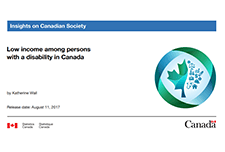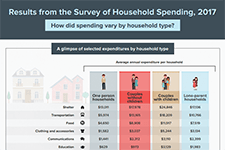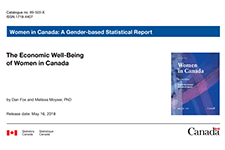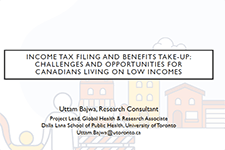Discover financial empowerment resources
Discover financial empowerment resources
The financial resources available to families with young children are an important factor affecting child development, and they can have long-term impacts on socioeconomic outcomes in adulthood. This article summarizes the findings of a new study using Statistic Canada’s data and analyzes the...

This article provides a high level overview of those living in social and affordable housing by painting a portrait of them based on the results of the 2018 CHS. Socio-demographic and household characteristics are examined using housing indicators such as core housing...

Persons with a disability face a higher risk of low income compared to the overall population. This report uses data from the 2014 Longitudinal and International Study of Adults (LISA) to study the relationship between low income and characteristics of people aged 25 to 64 with a disability,...

This infographic from Statistics Canada summarizes the results of the Survey of Household Spending, 2017, including average annual expenditures by household...

Economic well-being has both a present component and a future component. In the present, economic well-being is characterized by the ability of individuals and small groups, such as families or households, to consistently meet their basic needs, including food, clothing, housing, utilities, health...

In this presentation, Simon Brascoupé, Vice President, Education and Training, AFOA Canada, explains the financial wellness framework and how tax filing presents opportunities for building financial wellness in Indigenous communities. This presentation is from the session 'Closing the tax-filing...

In this presentation, Uttam Bajwa, Global Health and Research Associate with the Dalla Lana School of Public Health, University of Toronto, reports on tax filing challenges and opportunities for Canadians living on low incomes. This includes the challenges of not knowing what to do, fear and...

This report, 'The Perils of Living Paycheque to Paycheque: The relationship between income volatility and financial insecurity', examines the relationship between income instability and broader measures of financial well-being. This study makes use of a unique dataset that collected...

This is a pre-budget presentation from the Government of Canada on the state of the middle class in Canada. Middle class challenges, successes, and government commitments. All Canadians benefit from strong, sustained, and inclusive economic growth and everyone has a real and fair chance at economic...
This article examines changes in the wealth of Canadian families (i.e. total family assets minus total family debt) over the period from 1999 to 2012, with a particular focus on changes across income quintiles. The paper also examines changes in the concentration of wealth across income quintiles,...
Aboriginal women share some of the same demographic and socioeconomic characteristics as other women in Canada; however, there are also many important differences. Generally speaking, Aboriginal people in Canada are defined as three unique and distinct groups: First Nations (North American Indian),...
This study uses data from the National Household Survey (NHS) to examine the living arrangements of Aboriginal children aged 14 and under, and includes results about Aboriginal children who lived with a lone parent, with their grandparents, or in a stepfamily. The study also provides key statistics...
Low income lines are the most commonly used tool for defining and measuring poverty. They provide thresholds below which a household is considered to be living on low income. Low income lines can be constructed in different ways. This brief explains the LICO (Low income cut-off), LIM (Low income...
Good public policy matters and has been effective in reducing child poverty. Indeed, without government transfers over 2 million children would live in poverty. However, to date, policy inputs against poverty have been small and poverty reduction too limited. History has shown us that no one-off...
The Government of Canada is committed to strengthening the middle class and helping low-income Canadians exit poverty so that they have sufficient capabilities to be well and do well. To achieve this goal, we will need to form partnerships, modernize the existing landscape of supports and encourage...
This is a report on child poverty in British Columbia and connections to the working poor, employment insecurity, living on low incomes, and gives policy recommendations to respond to this...
Grande Prairie is not unique from other communities in that poverty and its effects can pose a challenging obstacle in the journey towards sustainability. In recognition of the need to address poverty within the community, Grande Prairie’s Community Action to End Poverty (CAEP) Committee was...
Using data gathered from the previous three censuses (2011, 2006, 2001) United Way/Centraide Windsor-Essex County, in partnership with the Great Lakes Institute of Environmental Research (GLIER), has mapped a number of the socio-economic indicators that have shaped Windsor and Essex County. Over...
